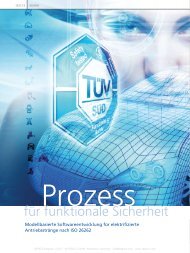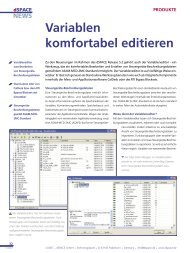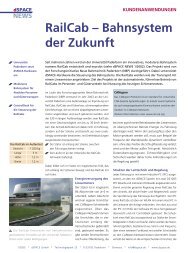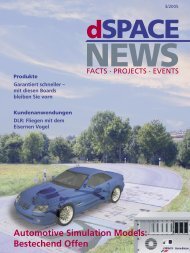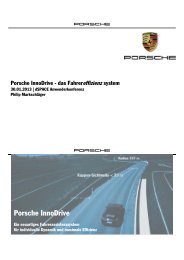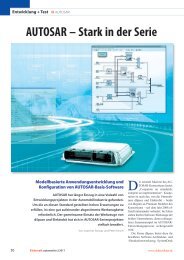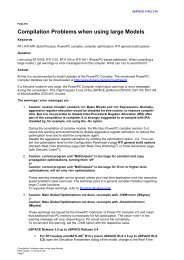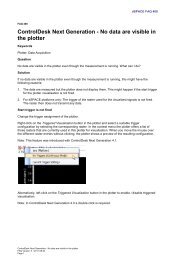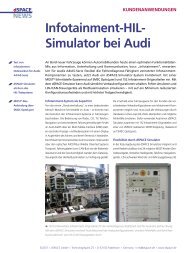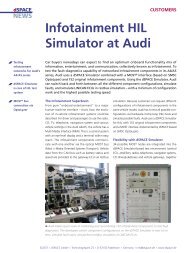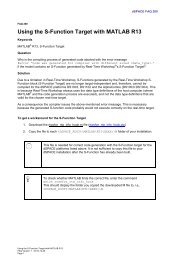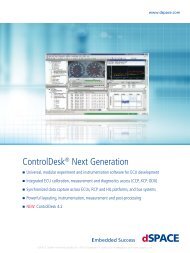Download - dSPACE
Download - dSPACE
Download - dSPACE
You also want an ePaper? Increase the reach of your titles
YUMPU automatically turns print PDFs into web optimized ePapers that Google loves.
page 52<br />
Ds1006 proCessor BoarD<br />
Quad<br />
Power<br />
Performance boost for HIL simulation with<br />
new DS1006 Processor Board<br />
<strong>dSPACE</strong> Magazine 1/2010 · © <strong>dSPACE</strong> GmbH, Paderborn, Germany · info@dspace.com · www.dspace.com
<strong>dSPACE</strong> has upgraded the DS1006 Processor Board – the heart of<br />
<strong>dSPACE</strong> real-time systems – with a Quad-Core AMD Opteron processor.<br />
The board now has even more power to meet the growing demands of<br />
hardware-in-the-loop (HIL) simulations. Large, processor-intensive models<br />
can be distributed easily across the processor cores and executed<br />
synchronously.<br />
Simulation Needs Performance<br />
HIL simulation is always hungry for<br />
greater computing performance.<br />
There are countless examples, such<br />
as the HIL simulation of electric<br />
motors for hybrid drives. These<br />
require high computing speeds<br />
because some tasks necessitate<br />
very short cycle times, for example,<br />
to allow oversampling even at high<br />
switching frequencies. Gasoline<br />
engines with variable valve timing<br />
and valve lift are another example.<br />
The usual mean-value models no<br />
longer suffice for these; more precise<br />
and therefore more processorintensive<br />
models are required. The<br />
same applies to diesel engines with<br />
in-cylinder pressure measurement.<br />
The new DS1006 supplies the performance<br />
needed for all these application<br />
cases and still has enough<br />
in reserve for further tasks. Various<br />
performance tests have shown that<br />
the new DS1006 is up to 60% faster<br />
than its predecessor in multiprocessor<br />
systems.<br />
The Solution: Multi-Core<br />
Processors<br />
For a long time, the usual method<br />
of boosting processor speed was to<br />
increase the clock rate. This method<br />
is coming up against its physical<br />
limits, however, as the heat buildup<br />
it causes is becoming unmanageable.<br />
The second common way<br />
in which speed is boosted is to im-<br />
Figure 1: Example of distributing a model across several cores of the DS1006. An ASM virtual<br />
vehicle consisting of three submodels (Drivetrain, Engine (with Soft_ECU_Gasoline) and Vehicle-<br />
Dynamics) is distributed across three of the four cores of a DS1006 and interconnected via<br />
9 IPC blocks.<br />
<strong>dSPACE</strong> Magazine 1/2010 · © <strong>dSPACE</strong> GmbH, Paderborn, Germany · info@dspace.com · www.dspace.com<br />
page 53
page 54<br />
Ds1006 proCessor BoarD<br />
DS1006 (Quad-Core)<br />
Gigalink<br />
3 x DS1006 (Single-Core)<br />
prove processor architecture, but<br />
here too, there is very little room<br />
for further improvement. Multi-core<br />
processors, i.e., ones with several<br />
CPU cores, are the way out of this<br />
dilemma. Each of the CPU cores<br />
has greater performance than earlier<br />
single-core processors, and the<br />
rapid data communication between<br />
the cores is a real bonus. The challenge<br />
of harnessing the great power<br />
of multi-core processors for realtime<br />
simulation therefore lies in<br />
thinking out how to handle all the<br />
different tasks, in other words, how<br />
to most usefully distribute and parallelize<br />
them, and how to organize<br />
communication between them.<br />
Model execution time (µs)<br />
Drivetrain<br />
Engine<br />
Vehicle dynamics<br />
17<br />
Model execution time (µs)<br />
Drivetrain<br />
Engine<br />
Vehicle dynamics<br />
Figure 2: Performance of the quad-core DS1006 2.8 GHz compared with its predecessor<br />
DS1006 2.6 GHz (each without I/O). Three submodels of the ASM virtual vehicle run simultaneously<br />
on three cores of the quad-core DS1006: drivetrain, engine and vehicle dynamics.<br />
Profile of the New DS1006 Processor Board<br />
36<br />
43<br />
66<br />
91<br />
141<br />
Made-to-Measure Power<br />
Where several DS1006 single-core<br />
boards used to be necessary in the<br />
past, only one single quad-core<br />
DS1006 Processor Board will often<br />
be needed in the future. This not<br />
only makes HIL simulators more<br />
cost-effective, it also provides greater<br />
flexibility for extensions. Naturally,<br />
multiprocessor systems can also be<br />
built in the usual way by connecting<br />
several new quad-core DS1006 processors<br />
together. Users can tailor<br />
the computing power to specific<br />
requirements in this way – whether<br />
they “only” want to process CPUintensive<br />
models, or need the modularity<br />
of multiprocessor systems to<br />
Quad-Core AMD Opteron processor, 2.8 GHz<br />
512 kB L2 cache per core; 6 MB L3 cache<br />
1 GB local memory for executing real-time models<br />
128 MB global memory per core for data exchange with the host PC<br />
2 MB on-board boot flash memory<br />
Optional application flash memory on a CompactFlash board for<br />
automatic, host-independent booting of real-time applications<br />
build a virtual vehicle from the test<br />
systems for individual ECUs or<br />
vehicle domains.<br />
Graphical Control via the Real-<br />
Time Interface<br />
The Real-Time Interface for Multiprocessor<br />
Systems (RTI-MP) is an<br />
implementation tool that supports<br />
users when they scale large, processorintensive<br />
models on their systems.<br />
Users can perform all the necessary<br />
steps on this one user interface,<br />
whether they want to use a single<br />
quad-core DS1006 board or build a<br />
system from several boards. RTI-MP<br />
lets users partition the models to<br />
ensure optimum utilization of the<br />
processor cores, and define and<br />
specify the communication channels<br />
for data transmission between the<br />
cores of the quad-core DS1006 in<br />
the same way as for multiprocessor<br />
systems. The communication parameters<br />
can be defined via interprocessor<br />
communication (IPC) blocks.<br />
This is done independently of how<br />
communication is actually performed<br />
physically, i.e., whether there are<br />
internal Gigalinks between several<br />
processor cores or optical Gigalinks<br />
between different processor boards.<br />
The cores of the new quad-core<br />
DS1006 not only compute several<br />
tasks synchronously, they can also<br />
execute several unsynchronized<br />
models at once.<br />
Comparison: The New DS1006<br />
and Its Predecessor<br />
The performance of the new quadcore<br />
DS1006 board is clearly shown<br />
when various <strong>dSPACE</strong> Automotive<br />
Simulation Models (ASM) are computed<br />
(figure 2 and figure 3), with<br />
each submodel running on one core<br />
of the board. The cores are all connected<br />
via internal Gigalinks.<br />
With the predecessor board, the<br />
single-core DS1006, each ASM<br />
model runs on its own board. The<br />
single-core DS1006 boards are connected<br />
via external Gigalinks.<br />
<strong>dSPACE</strong> Magazine 1/2010 · © <strong>dSPACE</strong> GmbH, Paderborn, Germany · info@dspace.com · www.dspace.com
Without connected I/O (figure 2),<br />
the time saving is between 35%<br />
and 60%, depending on the model<br />
being computed. This is largely due<br />
to the bandwidth of the internal<br />
Gigalink connections, in addition<br />
to the higher clock rate and the<br />
improved processor architecture.<br />
Even with connected I/O (figure 3),<br />
the new board is faster, despite<br />
the fact that I/O access to both<br />
DS2211s runs via a common pro-<br />
Gigalink<br />
PHS<br />
DS1006 (Quad-Core)<br />
2 x DS1006<br />
(Single-Core)<br />
PHS<br />
PHS<br />
2 x DS2211<br />
HIL I/O Board<br />
2 x DS2211<br />
HIL I/O Board<br />
cessor interface. The reason is the<br />
high speed of the internal Gigalink<br />
connections in the quad-core<br />
DS1006 – even though the number<br />
of signals transmitted here by no<br />
means uses the Gigalinks’ full<br />
potential.<br />
Basic gasoline engine<br />
Vehicle dynamics<br />
Basic gasoline engine<br />
Vehicle dynamics<br />
Model execution time (µs)<br />
Model execution time (µs)<br />
Conclusion<br />
With the new Quad-Core AMD<br />
Opteron processor, the new<br />
DS1006 Processor Board provides<br />
considerably more performance<br />
than its predecessor. Various tests<br />
showed that it achieves up to<br />
60% more speed than its predecessor<br />
in multiprocessor systems,<br />
depending on the model. As with<br />
other <strong>dSPACE</strong> boards, several of<br />
the new DS1006 Processor Boards<br />
can be used to build multiprocessor<br />
systems that increase performance<br />
even further. The HIL<br />
simulation of electric motors for<br />
hybrid drives, gasoline engines<br />
with variable valve timing, and<br />
diesel engines with in-cylinder<br />
pressure measurement are typical<br />
examples of applications that<br />
require greater computing performance.<br />
Users can conveniently<br />
partition all the computing tasks<br />
with the Real-Time Interface for<br />
Multiprocessor Systems (RTI-MP)<br />
software, whether they are handling<br />
a single DS1006 or a system<br />
made of several boards.<br />
Figure 3: Performance data of the quad-core DS1006 2.8 GHz compared with its predecessor DS1006 2.6 GHz (with I/O boards). Each main<br />
component of an ASM virtual vehicle, in this case the basic gasoline engine and vehicle dynamics, runs on one core of the quad-core DS1006.<br />
<strong>dSPACE</strong> Magazine 1/2010 · © <strong>dSPACE</strong> GmbH, Paderborn, Germany · info@dspace.com · www.dspace.com<br />
160<br />
170<br />
200<br />
220<br />
page 55




